It’s simple - children that eat well, learn well. But packing healthy school lunches is not always a simple task. While you can’t control how much or whether your child eats their lunch, you play an important role in what food is available to them while they are at school. That’s why we’re here to share our go-to guide to packing nutritious school lunches that are easy and enjoyable for everyone.
Lunchbox essentials
Including a variety of foods ensures your child will be full and energized so they can learn at their best. There are four essentials to every balanced lunchbox: vegetables, fruit, protein-rich foods and whole grains or starchy vegetables.
Vegetables
There’s no doubt about it, kids just aren’t getting enough vegetables. Vegetables are filled with vitamins, minerals and fibre essential to your child’s health. To help with packing school lunches, wash and cut veggies ahead of time and store in containers so they are ready to grab and go for lunches and snacks. Try to include a variety of colourful vegetables at every meal and most snacks. Fresh, frozen or canned—the choice is yours!
Fruit
Fruit is packed with nutrients and energy to help your child grow and learn. Try to include at least one serving of fruit in your child’s lunchbox each day. Local, in-season fruit is super tasty and is often more affordable. Canned fruit is perfectly okay; choose a kind packed in water or its own juice.
Protein-rich foods
Children need protein-rich foods for proper growth and development. Including a protein source at each meal and snack will help to keep your child healthy and full. Many protein-rich foods, such as yogurt and cheese, are also high in calcium and vitamin D, which are important for building strong bones and teeth. Choose a variety of protein-rich foods including beans and legumes, plain milk or fortified soy beverage, yogurt, cheese, eggs, seeds, fish, meat or poultry.
Whole grains or starchy vegetables
Whole grains and starchy vegetables such as potatoes and corn are packed with nutrients including vitamins, minerals and fibre making them a key part of a healthy diet. Including a variety of foods from this category is important to fuel your child’s body and brain.
How much should I pack?
Every child is different and their energy needs can change from day to day and year to year. Encourage your child to listen to their body to know when they are hungry or full. Make sure to include all of the lunchbox essentials each day and talk with your child to figure out if the portions you are packing are too big or too small.
Snack smart
Smart snacks are those that include two or more lunchbox essentials. Try to always include a veggie or fruit and combine with a protein-rich food to help keep your child energized until their next meal or snack.

What’s to drink?
Keeping hydrated is essential for your child to focus and learn their best. Send your child with a reusable water bottle every day. Milk and plain fortified soy beverage are also great hydration options.
Lunchbox safety
It is important to make sure the lunches and snacks you pack are safe to eat. Keep perishable foods cold by using an ice pack and an insulated lunch bag. If packing a hot lunch, make sure to use an insulated thermos. Pre-warm the thermos by filling with boiling water. Let stand for a few minutes before emptying and filling with the hot lunch food. Always encourage your child to wash their hands before and after they eat.
What about ‘sometimes’ foods?
Though we’ve only been chatting about ‘everyday’ foods, your child’s lunches might include ‘sometimes’ foods (e.g., chips, cookies) occasionally. Healthy eating means eating a balance and variety of foods, including nutritious ‘everyday’ foods most often and some high-energy and low- nutrient ‘sometimes’ foods. An important part of developing a healthy relationship with food is enjoying eating, feeling good about what we eat, and having a relaxed attitude towards ‘sometimes’ foods. To help your child develop a healthy relationship with food, you should try to avoid labelling foods as ‘good’ or ‘bad’.
Involve your child
Involving your child in planning and packing helps to develop valuable skills that will last a lifetime. Not only that, children are more likely to eat and try new foods that they helped prepare! It is never too early or late to get kids in the kitchen with these age-appropriate cooking tasks. Before you know it, they’ll be packing lunch all on their own!
